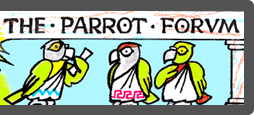 by Pajarita » Tue May 18, 2021 9:50 am
by Pajarita » Tue May 18, 2021 9:50 am
Hi, Philly and Gray (you did not tell us her name), welcome to the forum.
Yes, Tops are the best pellets -not Harrison's- and the Zupreem colored pellets are, pretty much, the worse - the Pretty Bird African gray food also has artificial colors and flavors. In my personal experience, Grays are picky, picky eaters and difficult to switch to a better diet but it's not impossible if you time and present food the 'right' way and, above all else, you are persistent and patient about it. To make a long story short, it takes years and a lot of experimenting.
Now, having said that, I do not feed pellets. I've been doing research on their natural diets since 1994 and am 100% sure that pellets are not and never will be the best dietary option for parrots (I can elaborate on this, if you wish). I feed gloop and raw produce for breakfast and nuts and/or seeds, if it's a small species, for dinner with a multivitamin/mineral supplement twice or three times a week. I have transitioned literally hundreds of birds to gloop and have never had a single problem doing it (I do it in a matter of days because they all love it) - not even with seed junkies. See, the thing is that gloop conforms to the same macronutrients levels that they eat in the wild while pellets do not (among other problems that pellets have).
In all honesty, I don't really know how to switch a parrot to a different kind of pellet because I haven't fed pellets for many years now (I tried once because I figured that if I had to rehome a bird, it would be best if it was used to pellets) and my method of switching to gloop cannot be used to switch pellets but I will tell you what I do in case you decide to try gloop.
The trick is timing and a bit of a 'bait'. I serve the gloop at dawn (which is the time of the day that parrots are 'hardwired' to eat the most because they are at their hungriest after a whole night of not eating) with a little sprinkle of some small seeds (like a budgie or a conure mix, for example) mixed in and just leave it there all day long. At dusk, I take away the gloop and replace it with a measured portion of nuts and/or seeds. Next morning, same thing. The birds never eat the gloop on the first day and most of them don't even do it the second day but they will pick the seeds out of the gloop and, on the third or fourth day, they will start eating the grains (and you know because you find little white empty 'skins') and the corn (they all LOVE corn) and, as the days go by, they start eating the other veggies too. I also serve raw produce every day: one fruit, one veggie and one leafy green - a different one each day of the week and always trying to 'mix colors' like I would give a red fruit with a green veggie (for example, raspberries and green peppers) or a blue fruit with a yellow veggie (blueberries and yellow zucchini). Grays are not into leafy greens but they do love raw broccoli and crunchy stalks (like Swiss chard, bock choy or even the very heart of a romaine).
Like I said, it takes years to get a bird to eat a good range of veggies and fruits - I had a gray that took five years to try her first blueberry even though she got them once a week and all birds love blueberries and, once she tried them, she loved them and kept on eating them. One good way to make them try something new is to eat with them (not your food but theirs). Put her on your shoulder and, very nonchalantly, simply eat your piece of fruit (grays like juicy fruits like ripe pears, cantaloupe, etc) without offering her any and, eventually, she will want to try what you are eating (she will stretch out her neck and try to take a bite out of your piece) because the 'parrot see, parrot does' is kind of hardwired in them when it comes to food as this is the way their parents teach them what is good and what is not good to eat. Basically, they see the parent eating something and this tells them it's good - as we take on the role of parents with our pets, it works for us, too.
Now, I don't want to make you feel bad because I can tell that you are already worried about her diet and trying very hard to improve it but, regardless of what you end up deciding on her 'staple' food, you NEED to make her eat more raw produce because contrary to what manufacturers claim on their labels, pellets are not anywhere near a 'complete' food - they are dry and processed so, as far as nature is concerned, it's 'dead' food, it has no phytonutrients, no live enzymes, no live bacteria (the good kind they need for their gut which, in turn, supports their immune system). And they know it, too! If you look at the labels, you will see that they all have added vit B12 which is something that herbivores produce themselves in their gut so why would they add a vitamin that the bird produces itself? Because it's dead food and the bird needs good bacteria in their gut to produce it, something that pellets cannot offer so they have to add it! These things are only found in raw food which is what parrots evolved to eat. And, although the nutritional label looks very good, in reality, it's not as good as it looks because the vitamins are all lab-made instead of food derived and we now know that lab-made are not as efficient as the ones that nature created (it has to do with bioavailability).
Also, please do not feed her the High Potency. These pellets used to come with a warning label on the package advising customers to only feed them to birds that were breeding, sick or weak and never for more than 6 months but, all of a sudden, the label disappeared - most likely so they could sell more. See, the pet food industry is completely unregulated and, although dog and cat foods need to follow some industry standards, there aren't any for any other kind of animal and the manufacturers can claim whatever they want without any legal consequences. The truth is that the High Potency is a bomb of protein and vitamins - two things that are good in the right levels but real bad when you get too much of them.
I wish I could offer you better advice on the pellets but, like I said, I gave up on the a long time ago...





